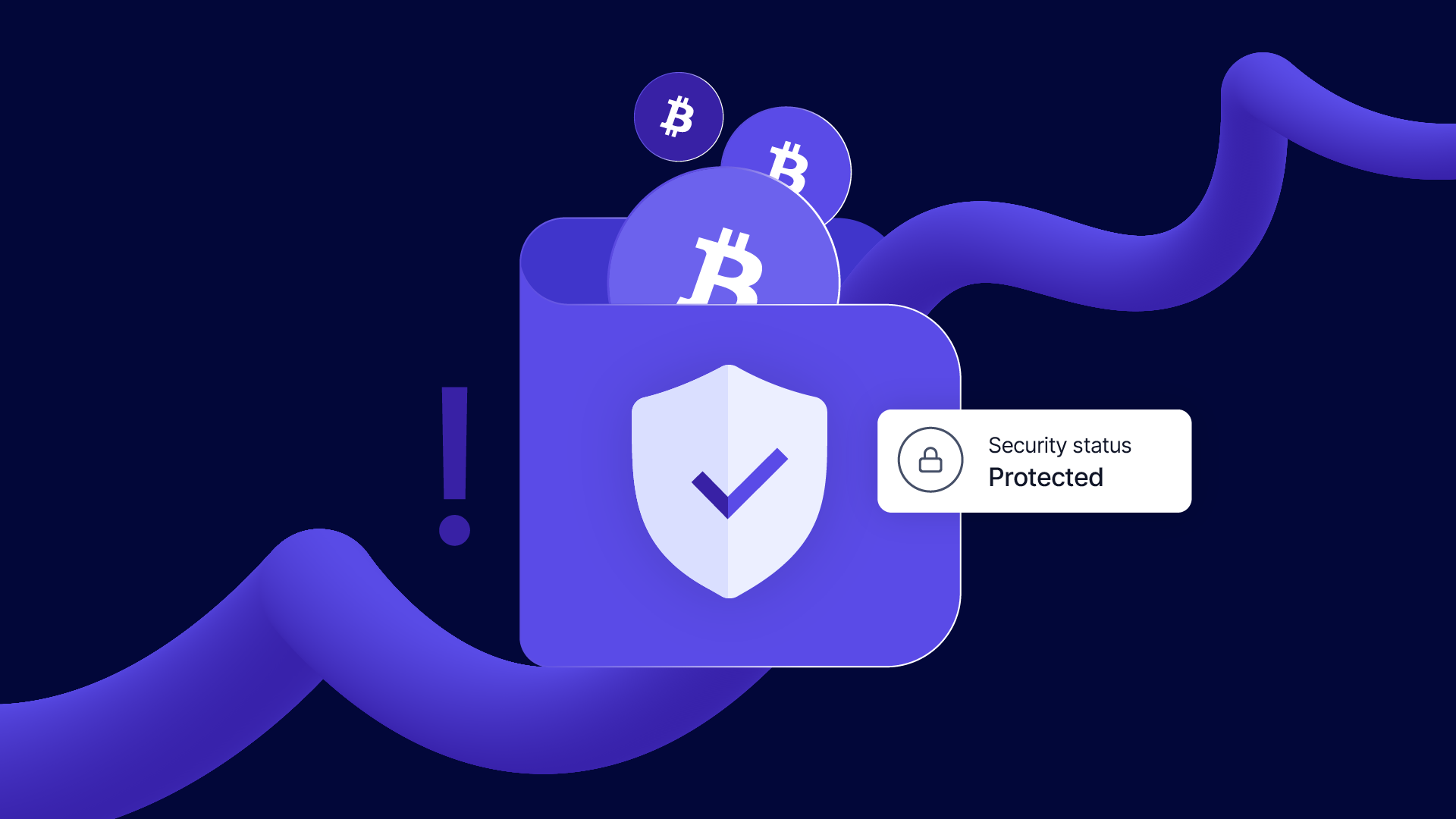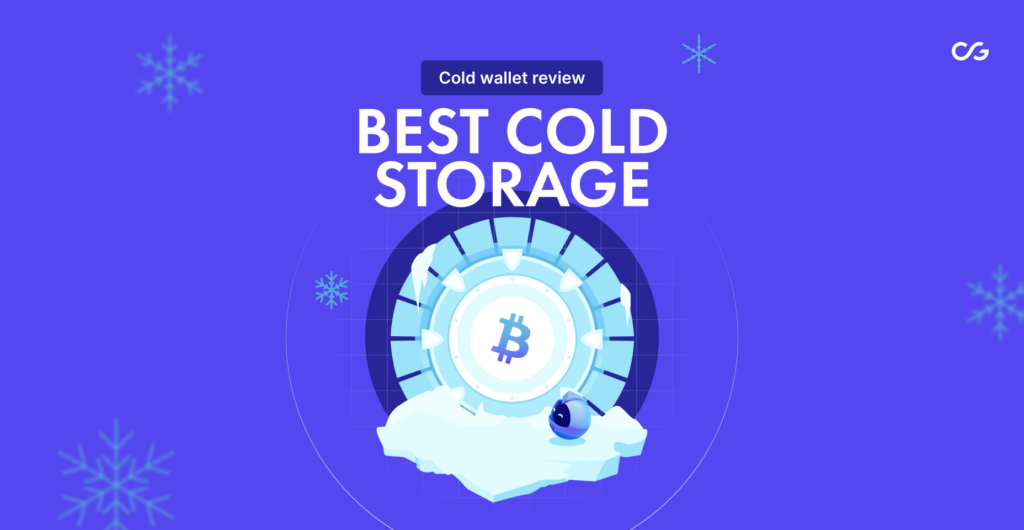
Crypto Wallet Protection: How To Protect Your Wallet From Hacks & Cyber Attacks 2025

While blockchain technology offers security and privacy, the increasing sophistication of cyber threats poses a significant risk to investors.
Whether you’re a newcomer or a seasoned trader, understanding the safest way to store crypto and how to protect your crypto from potential threats and hacks is crucial.
In this short guide, we’ll lead you through the best practices for crypto security, highlighting the best way to store crypto, how to keep your crypto safe, and in particular, how to move crypto to one of these cold storage devices (a crypto wallet – read more below):
Despite the inherent security features of cryptocurrencies, the environment has its own unique vulnerabilities that can jeopardize your assets – from phishing attacks to exchange hacks.
As there’s typically no recourse once your crypto is stolen – no ‘bank’ to call and no insurance to claim – securing your digital wallet becomes even more critical.
In this easy-to-follow guide, we’ll explore effective strategies on how to keep your crypto safe. Plus, we’ll offer advice on the best ways to store crypto and how to ensure that your investments are shielded against constantly evolving threats.
What you’ll learn:
- What you need to know about crypto security
- First Up – What is a crypto wallet?
- Best practices for protecting your crypto wallet
- What are the best cold wallets?
- How to store cryptocurrency in cold storage
- Key Takeaways
- The safest way to save crypto
- FAQs
What you Need to Know About Crypto Security
Crypto wallets face various security threats that can jeopardize the safety of your digital assets. Here’s an overview of some common threats to crypto wallets:
- Phishing Attacks – Phishing attacks are deceptive attempts to steal sensitive information, such as private keys or login credentials, by masquerading as a trustworthy entity in electronic communications. Users may be lured to malicious websites that look remarkably similar to legitimate ones, where they unwittingly enter their private information.
- Malware – Malicious software can infect a device, allowing attackers to log keystrokes, steal data, or even take control of the computer. Some malware is designed to target cryptocurrency wallets to access private keys and steal funds.
- Ransomware – This type of malware locks you out of your device or encrypts your files, demanding a ransom to restore access. In some cases, ransomware can target and encrypt wallet files, demanding payment in cryptocurrency to unlock them.
- Man-in-the-Middle Attacks (MITM) – In this scenario, attackers intercept the communication between two parties (such as between a user and a crypto exchange) to steal or manipulate the data being exchanged.
- Exchange Hacks – Even if your personal security is robust, the platforms where you trade or store your cryptocurrency might not be.
- SIM Swapping – Attackers take control of a victim’s mobile phone number by convincing the carrier to switch the number to a SIM card they own. They can then bypass SMS-based two-factor authentication to access cryptocurrency accounts.
- Wallet Software Flaws – Vulnerabilities in the wallet software itself can also be a risk. If bugs or flaws exist in the software’s code, attackers could exploit these to access the wallet’s funds.
- Physical Theft or Loss – If a hardware wallet (a physical device that stores cryptocurrency offline) is lost or stolen, and adequate security measures like a PIN or recovery phrase aren’t in place, potentially, the contents can be accessed by unauthorized persons.
To protect against these threats, it’s crucial to use a combination of strong, unique passwords, enable two-factor authentication, keep wallet software updated, and be vigilant against phishing attempts.
Additionally, using a hardware wallet for storing large amounts of cryptocurrencies can significantly increase security by keeping the keys offline and away from potential online vulnerabilities.
First Up – What is a Crypto Wallet?
A crypto wallet is a digital tool that allows you to store, send, and receive cryptocurrencies such as Bitcoin, Ethereum, and many others.
Unlike a physical wallet that holds physical currency, a crypto wallet doesn’t actually store your crypto assets physically. Instead, it securely saves your cryptographic keys – public and private – which are used to interact with blockchain networks where your cryptocurrencies are recorded.
The public key is akin to an account number that you can share with others to receive cryptocurrencies. The private key is similar to a PIN or a password, and it is essential for accessing your crypto holdings and authorizing transactions.
It’s also critical to keep your private key secure because anyone who has it can access your cryptocurrency.
Crypto wallets come in various forms, including software wallets (like those hosted on a smartphone app or a computer), hardware wallets (physical devices that store keys securely and offline), and paper wallets (physical documents containing your public and private keys).
Each type offers different levels of security and convenience, depending on how you intend to use and manage your cryptocurrencies.
Best Practices for Protecting Your Crypto Wallet
To create a safe wallet environment, it’s essential to begin with strong, unique passwords.
Use Strong, Unique Passwords
Complex passwords that mix letters, numbers, and symbols are fundamental, and each should be distinct to prevent weaknesses that can be exploited across platforms.
A reputable password manager can be invaluable here, generating and storing passwords securely – you already know how easy it is to lose passwords.
Enable Two-Factor Authentication (2FA)
Adding a second layer of security through two-factor authentication (2FA) hugely bolsters your wallet’s defenses.
This requires not just a password but a second form of verification, typically a code sent to your phone or generated by an app. This extra step ensures that even if someone manages to decipher your password, they won’t be able to access your account without the additional code.
Regular Software Updates
Keeping your wallet software and any associated apps updated is another crucial practice.
Developers regularly release updates to fix bugs and patch security threats. By ensuring you’re running the latest version, you protect your assets against known threats with the latest security updates.
Be Wary of Phishing Attempts
Phishing is a technique used by cybercriminals to extract sensitive information. Always verify the authenticity of emails or messages before interacting with any links or attachments.
Be skeptical of requests for urgent actions or personal details, and stick to well-known and verified websites and contacts.
Browser extensions that detect phishing sites can also enhance your security.
Secure Internet Connections
Finally, always use a secure, private internet connection when managing or transacting with your crypto wallet.
Public Wi-Fi networks pose several security risks, such as the potential for data interception.
For an added layer of security, especially when a private connection isn’t available, consider using a virtual private network (VPN) to conceal your activities from potential threats and intrusions.
By implementing these strategies into your daily digital routines, you not only safeguard your crypto wallet but you also increase your overall digital security.
Top Tip:
Spreading your cryptocurrency assets across multiple wallets is not just a wise investment strategy, but it’s also a crucial one. Never store all your digital assets in a single wallet, regardless of whether it’s hot or cold storage.
What are the Best Cold Wallets?
Before we answer the question ‘What are the best cold wallets’, let’s understand what a cold wallet is.

Cold wallets, also known as hardware wallets or offline wallets, are devices designed to store cryptocurrency offline, away from any internet connection, making them one of the safest options for holding digital assets.
Unlike hot wallets, which are connected to the internet and susceptible to hacking, cold wallets store your private keys on a physical device similar to a USB drive, ensuring that your assets remain secure from online threats such as malware, phishing scams, and unauthorized access.
Since cold wallets are not connected to the internet, they are immune to online hacking attempts and reduce the risk of exposure to viruses or phishing attacks.
If you’re looking for the best place to store crypto, several models of cold wallets have gained popularity due to their reliability and robust security features.
Examples include:
- Cypherock – Cypherock X1 sets a new standard in crypto security by decentralizing key storage, and eliminating seed phrase risks with keys split across four NFC cards and a device. This secure, user-friendly wallet allows easy asset management through the cySync app. Backed by industry leaders and rigorous audits, Cypherock X1 offers top-tier crypto protection.
- COLDCARD Wallet – COLDCARD is the world’s most trusted and secure Bitcoin signing device. It is an easy-to-use, ultra-secure, open-source, and affordable hardware wallet that is easy to back up via an encrypted microSD card
- NGRAVE – Your backup should be straightforward for you to comprehend but a puzzle to everyone else. Your keys remain secure with the premier encrypted and recoverable stainless steel backup.
- SafePal – SafePal is at the forefront of enhancing the crypto user experience. Their crypto wallets are quick, user-friendly, and all controlled through a single, straightforward app.
- Tapsigner – TapSigner is a wireless NFC smart card that holds your Bitcoin private key (XPRV) and will sign transactions with a simple tap on your phone
If you’re serious about cryptocurrency security, investing in a cold wallet should be a priority.
Not only do they give you superior protection against cyber threats, but they also offer peace of mind by ensuring that your digital assets are not accessible by third parties.
When choosing a cold wallet, consider the following factors:
- The types of currencies supported
- Ease of use
- Security features
- Compatibility with other software or exchanges
Understanding these factors will ensure you choose a wallet that suits your unique needs and security requirements.
You can learn more about cold wallets here.
Get Extra Protection
How to Store Cryptocurrency in Cold Storage
Storing cryptocurrency securely is paramount, and using cold storage is one of the most effective methods to ensure the safety of your assets.
Here’s a detailed guide on how to store your cryptocurrency in cold storage:
Get a Cold Storage Device
The first step in securing your cryptocurrency is to get a cold storage device. It’s advisable to choose a device that supports Bluetooth connectivity for ease of use and portability. These devices, often resembling USB drives or small gadgets, are essential for keeping your crypto assets offline and safe from potential online threats.
Download the Software
Once you have your cold storage device, the next step involves setting it up. This usually requires downloading the corresponding software onto your PC.
Save your Recovery Phrase
A critical component of setting up your cold wallet is saving your recovery (seed) phrase. This phrase acts as a fail-safe, enabling you to regain access to your cryptocurrencies should you forget your PIN or password.
It is vital to store this phrase securely and ensure it’s memorable. The recovery phrase is your ultimate backup and should be treated with the highest level of security.
Create a new Wallet Address
Next, you’ll need to create a new wallet address for each type of cryptocurrency you intend to store.
This unique address will be used to transfer crypto from your current (likely online) wallet to your cold storage device. Each transaction requires careful attention to detail to ensure the correct address is used.
Send your Crypto to the Corresponding Address
Finally, when you transfer your cryptocurrencies to the cold storage wallet, double-check the recipient address meticulously. Errors in this step, such as sending Bitcoin to an Ethereum address, can result in irreversible losses.
Key Takeaways about Crypto Wallets
- Cold storage involves transferring your cryptocurrency keys from a wallet that’s connected to the internet to one that is entirely offline, significantly enhancing security.
- This method is notably less convenient than other forms of digital storage; however, this inconvenience is directly correlated with increased security. Essentially, the more cumbersome a storage method is to access, the safer your assets are likely to be.
- There are various cold storage methods available, each offering different levels of security and accessibility to suit diverse needs and preferences.
- By choosing a suitable cold storage option, you can balance security with ease of use according to your specific requirements.
The Safest Way to Save Crypto
Safeguarding your cryptocurrency involves a combination of careful practices and the right technology.
From choosing robust cold storage solutions to maintaining vigilant oversight of your digital transactions, each step is crucial in protecting your assets from the myriad threats that exist in the digital world.
Always use multiple wallets, enable strong security measures like two-factor authentication, and stay updated on the latest in cybersecurity to defend against potential vulnerabilities.
Remember, the responsibility to secure your crypto assets lies with you; by taking proactive steps today, you can ensure the safety of your investments for the future.
FAQs
What are Crypto Hot Wallets?
Hot wallets differ from their cold counterparts by being connected to the internet. This connection is necessary for accessing and managing your cryptocurrencies.
While this makes hot wallets more vulnerable to online threats and hacks, they provide the convenience of easy and quick access for frequent transactions. Today, the market offers a wide variety of hot wallets, catering to different needs and preferences of users.
What are the Risks Associated with Storing Crypto in an Exchange?
Storing cryptocurrency on an exchange might seem convenient, but it carries significant risks. Although it offers easy access, it also exposes your assets to potential cyber-attacks.
Even if your passwords and private keys are secure, an attack on the exchange itself could lead to irreversible loss of your cryptocurrency.
Are There Any Risks Associated With Cold Wallet Storage?
While cold storage wallets are widely considered the safest method for keeping your cryptocurrency secure from online threats, they are not without their vulnerabilities.
The physical nature of cold storage devices means they can be lost or stolen, putting your assets at risk. Additionally, physical damage from elements like water or fire can render them useless, potentially causing total loss of your crypto if you haven’t backed up your seed phrase.
All of that means that while cold storage offers robust protection against digital threats, it also demands careful physical safeguarding and contingency planning to ensure the security of your assets.
Can You Store Multiple Cryptocurrencies in One Wallet?
Yes, it is possible to store multiple cryptocurrencies in a single wallet. Many cryptocurrency wallets and exchanges are designed to support numerous digital currencies, automatically creating individual wallets for each type under one account.
In some instances, you may need to manually configure a new wallet within the same account to accommodate a different cryptocurrency.
For optimal security and convenience, the ideal choice for storing a diverse range of cryptocurrencies would be a cold wallet – one that is portable, secure, and offline.
Accept crypto with CoinGate
Accept crypto with confidence using everything you need in one platform.






